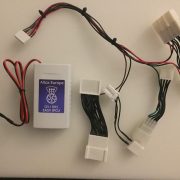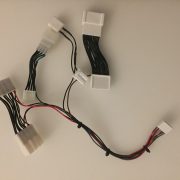Product Description
CONTROL OF THE INTERIOR BLOWER
The D3/RRS EASY IPCU module turns on the inner fans. It controls the fan relay and regulates the fan speed. The fan speed can be adjusted via a trim potentiometer.
When controlled by the Altox W-bus 5, we recommend setting startup temperature for D3/RRS EASY IPCU between 40-50 Celcius , (this is done by texting LTEPM1:## to your Altox W-bus 5) to prevent unnecessary usage of battery power, then fans will not kick in before coolant is warm
Set potentiometer to a speed that equals between level 1 or 2 when using the temperature controlled startup
if used with other devices that can’t delay startup time it should and must only run relatively slowly. We recommend a speed equal to level 1 or less.
we recommend always having a healthy Battery
CONTROL OF THE VENTILATION FLAPS
In order to allow air to flow not only to the footwell but also to the windshield when the interior blower is switched on and to be routed through the heat exchanger, the D3/RRS EASY IPCU module interrupts the control lines to the actuators of the dampers with the ignition switched off. Thus, the vehicle can no longer automatically close the flaps around 2 minutes after the ignition is switched off.
The air distribution when switching on the fan is the same as before switching off the ignition. For optimal warming, the temperature should be set to maximum so that the mixing flap in front of the heat exchanger is completely open and, if necessary, the air distribution on the windshield. The Defrost setting is not recommended, as the temperature is not changed in this program and therefore the heat exchanger flap may not be fully open.
SUMMER / WINTER SWITCH
In order to avoid the calibration of the ventilation flaps each time the ignition is switched on, the IPCU module can be switched to summer mode via a switch provided. The switch can either be in the glove compartment (drilling needed) or simply remain behind the center console trim. If required, it can be removed within seconds and gives access to the switch.
CONTROLLING
The D3/RRS EASY IPCU module is powered/operated in 2 ways, depending on switch setting inside the D3/RRS EASY IPCU
A = +12 volt (one wire only)
B = +12 volt and Ground as control signal (Factory setting)
ALTOX Wbus-5
Switch set to B, Connect white and yellow wire from EASY IPCU to white and yellow wire from ALTOX Wbus-5
BAS-FBHIC3
Switch set to A, Connect white wire from EASY IPCU to brown wire on BAS-FBHIC3
Bells Intelligent FBH controller and other Controllers without OUTput
Switch set to A, Connect white wire from EASY IPCU to the FBH (top left plug, Black cable) because the OLD BAS control does not provide an output signal
Webasto timer
For the Webasto 1533 pre-selection clock, Pin 2 (Out / black) supplies the necessary switching voltage
LIMITATIONS
The simple interruption of the control line triggers a calibration of the control lines each time the ignition is turned on, also stored in the error memory messages.
A microprocessor controlled solution would have been better, but would lead to much higher price. That’s why we choose to make a relay controller, but we do not want to hide the consequences. Calibration can be prevented via the “summer switch”.
Installation
The connection of the D3/RRS EASY IPCU module takes place behind climate control unit with the plug and play cable loom, then connected to controller or heater according to instructions
Will only be plug and play on cars with Seat heating, it is possible to connect without seat heating, but takes a little more work






Reviews
There are no reviews yet.